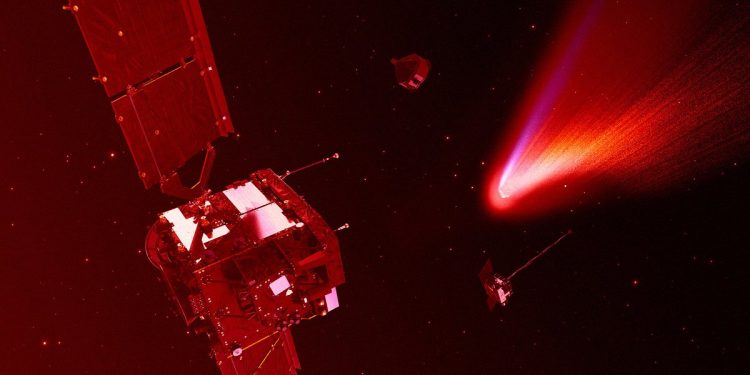The interstellar object 3I/ATLAS continues to fascinate astronomers as it passes through our solar system. And the more we learn about this object – widely believed to be an icy comet – the more questions emerge.
Latest among these mysteries: The Keck II telescope in Hawaii observed the object when it was just over 2.5 times the distance between Earth and the Sun in August, and found “evidence of a puzzling anti-tail extension in the direction of the Sun,” as Harvard astronomer Avi Loeb wrote in a blog post last week.
In a recent paper that has not yet been peer-reviewed, a team of astronomers used Keck data to confirm “previously reported cyanide and nickel outgassing,” which are emitted both in and against the direction of the Sun, providing “clear evidence of an anti-tail,” according to Loeb.
“Most notable is that the 3I/ATLAS white light image does not show evidence of a familiar cometary tail, as would be expected for dust that scatters sunlight and is pushed away from the Sun by the pressure of solar radiation,” he added.
As IFLScience explains, the phenomenon could be the result of natural processes. One possibility is that this is a type of optical illusion; Because of Earth’s relative position in space, a comet’s broad tail can extend behind it to appear as if it has a tail growing from either side.
Another possibility is that the larger dust grains refuse to be pushed by the solar wind to the Sun-facing side of the comet. The comet’s sublimating ice core could spin rapidly and release large chunks of debris back and forth along its orbit, making it appear as if it has an “anti-tail” facing the Sun in addition to its normal tail.
Scientists have already identified other comets exhibiting “anti-tails” oriented toward the Sun, suggesting a “slow ejection of relatively large dust particles, primarily from the sunlit hemisphere.”
“With a rotating comet core… ejecta from one point can break away with a heliocentric velocity that puts them in front of or behind the core,” explained Michael Busch, a planetary astronomer at the University of California, Los Angeles, in an article on Bluesky. “It doesn’t matter which way we go.”
“Small dust and ejected gases are expelled by radiation pressure and solar wind,” he explained in a follow-up statement. “But larger pieces of ejecta were distributed along the orbit, both in front of and behind the core.”
For Loeb, the anti-tail remains an “anomaly that raises two questions,” according to a more recent blog post. “What is the nature of the anti-tail? Why do comet experts ignore this anomaly while insisting that 3I/ATLAS is a familiar comet?”
Fortunately, before 3I/ATLAS leaves the solar system for good, it will give us several more opportunities to examine it. It is expected to come up close to Jupiter next month, giving NASA’s Juno spacecraft and the European Space Agency’s Juice spacecraft a chance to get a brief glimpse.
For now, Loeb rates 3I/ATLAS a four out of ten on his “Loeb scale” – which he invented to assess the likelihood that an interstellar object is extraterrestrial technology – in a number that he says means it has “increasingly anomalous characteristics.”
Learn more about 3I/ATLAS: Interstellar object projects something strange, scientists say









